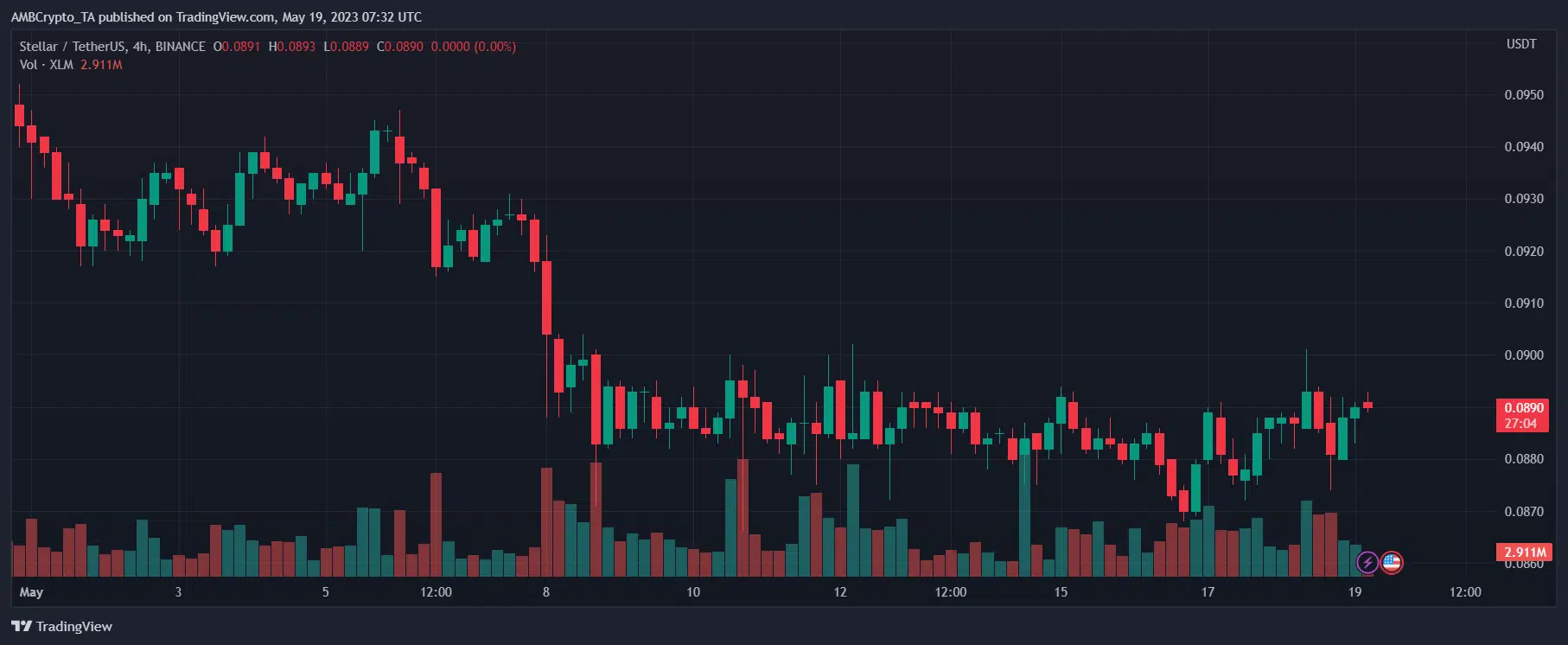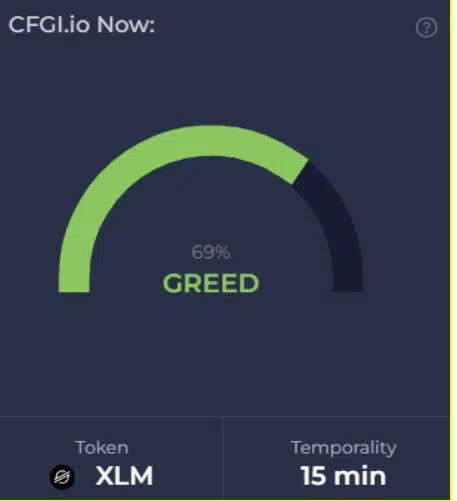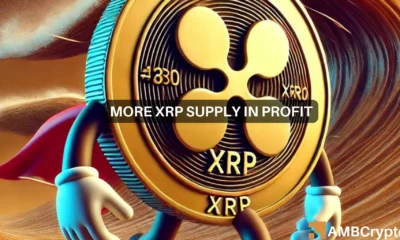Stellar Price Prediction 2025-30: Is there an end in sight for XLM’s woes

Disclaimer: The datasets shared in the following article have been compiled from a set of online resources and do not reflect AMBCrypto’s own research on the subject.
Recently, Stellar integrated with AI-powered cyber security company, AnChain.AI, to boost security for its cross-border payments. However, a look at Stellar’s development activity indicator didn’t evoke much optimism.
After climbing to a 2-month high in the first week of May, it fell precipitously as the month progressed.
The price of Stellar Lumens (XLM) has dropped drastically since the beginning of April. Going by the general trend in the crypto market right now, we should be prepared for a further bearish price movement of the token.
At press time, XLM was trading at $0.08918.
In April, Brazil’s central bank launched the pilot for its experimental central bank digital currency (CBDC). The test for Brazilian CBDC, Digital Real, is taking place on the Stellar blockchain network.
Soon thereafter, Pendulum announced the release of the Spacewalk bridge that connects the Polkadot infrastructure to Stellar’s blockchain so Polkadot can access fiat and stablecoin currencies. The Spacewalk bridge will allow Polkadot to access the entire infrastructure created by Stellar, especially that related to cross-border payments.
? Spacewalk live!
We're thrilled to release our bridge, connecting @StellarOrg with @Polkadot!
Our developer's hard work is coming to fruition – we're taking flight on @amplitude_chain ??
Explore Spacewalk in this @CoinDesk article by @IanAllison123 ?https://t.co/Eithx39jE7
— Pendulum (@pendulum_chain) March 13, 2023
The trust of large institutions in the Stellar network is a primary reason for its strong market presence.
Read Price Prediction for Stellar (XLM) 2023-24
Stellar is today one of the best platforms for facilitating faster and easier international financial transactions. It is based on a decentralized on-chain protocol. Stellar users trade in Lumens (XLM) which is the platform’s native cryptocurrency.
Another important feature of Stellar is that individuals are more interested in Stellar than organizations, as it is a platform for small-amount payments. It is gaining popularity due to its simple user interface.
Stellar enables real-time transactions to occur anywhere in the world in as little as five seconds. A new smart contracts platform called Soroban has released its second preview. The upgrade intends to increase platform developer friendliness, scalability, and sensibility.
Last year, Ethereum transitioned from the proof-of-work (PoS) to proof-of-stake (PoS) consensus mechanism following the Merge. A major reason for this step was claimed to be the adoption of eco-friendly processes. In this regard, Stellar is very promising, as it has a smaller carbon footprint. Its authentication cycle is also fast, keeping energy use to a minimum.
Acting as a decentralized currency exchange, Stellar helps you track all of your assets with an order book. You can sell, buy and manage all of your assets here, with XLM acting as an intermediate currency for paying transaction fees. The currency is very useful for the users because it helps you reduce transaction costs.
Transactions on the Stellar platform are performed swiftly due to the ease of Lumens. The currency not only makes transactions seamless for the sender and the recipient but also ensures that transactions are secure.
Jed McCaleb, Co-founder, and CTO of Stellar said in an interview with CoinMarketCap that XLM is used in a fundamental way for the network.
“Maybe that affects the price, maybe price is a secondary indicator of how useful the underlying protocol is in some way… But I think that the trend is there: that where price and utility can come into play.”
XLM is listed on a number of crypto exchanges including Binance, eToro, Huobi Global, CoinTiger, FTX, and OKEx. This shows that the currency is an increasingly accepted choice of investors now.
A total of 100 billion XLMs were issued when the Stellar network was launched in 2015. In 2019, the group announced that it was burning over half of the cryptocurrency’s supply. Stellar mentions on its website that currently, there are around 50 billion XLMs in existence; 20 billion XLMs are in circulation and 30 billion XLMs are retained by the Stellar Development Foundation for project development. Nothing more will be created.
Due to its increasing adoption, XLM is among the top 30 cryptocurrencies in the world right now, with a market cap of around $2.3 billion.
Why these projections matter
Where Stellar trumps other financial platforms is its low transaction fees, which have drawn a huge number of cryptocurrency users to it. It is one of the few blockchain networks that has been successful in collaborating with large tech corporations, such as Deloitte and IBM. Stellar, in partnership with IBM, launched a project that enables FinTech to engage in financial transactions using assets such as stablecoins.
It must be noted that Stellar is one of the large corporations that are operating in the cryptocurrency market. It is one of the most centralized cryptocurrency networks active on the internet. While the Stellar network uses decentralized nodes, it doesn’t have that many validators. Such an infrastructure gives the group a lot of control over the operations and price movement of XLM.
In 2016, Deloitte announced a partnership with Stellar, along with four other blockchain networks, to provide new technological capabilities to its global financial institution client base.
In June 2018, Fortune reported that New York financial regulators approved Stellar Lumens to trade on the Bit exchange, the first time the state’s authorities have given it the green light.
In October 2021, IBM partnered with Stellar to facilitate cross-border payments by banks. The system uses XLM as a bridge currency for transactions and it has been successful in the South Pacific region.
The same year, Moneygram announced a partnership with Stellar. Its integration with Stellar facilitates the conversion of the USDC stablecoin into cash and vice versa. The facility aims to encourage the liquidity of cryptocurrencies and the integration of traditional and cryptocurrency markets.
In October 2021, Flutterwave, a global payments technology company, also announced two new remittance corridors between Europe and Africa on the Stellar network. The step is a major step in Stellar’s expansion in the global market.
It also succeeded in receiving certification from the Islamic scholars of Bahrain in 2018, aiming to integrate the technology into the field of sharia-compliant financial products, reported Reuters.
“We have been looking to work with companies that facilitate remittances, including in the United Arab Emirates, Saudi Arabia, and Bahrain. It’s a huge market,” said Lisa Nestor, the then-director of partnerships at Stellar. Since the Middle East and South Asian regions are key areas of growth for the group, where a lot of countries are run on a sharia-compliant system, this is a major success for Stellar.
Developing economies are the focus of the Stellar network in the areas of remittances and loans. It primarily aims to target those who are still not part of the traditional banking system.
In June 2022, the global platform for modern money movement, Nium, and Stellar announced a partnership to enable payouts to 190 countries. “This integration truly drives home the value that blockchain-powered cross-border payment solutions bring to the current financial system,” said Denelle Dixon, CEO and Executive Director of the Stellar Development Foundation. “At SDF, we are always working to fill up the map and connect the network to more of the globe. Together with Nium, we are thrilled to expand the reach of the Stellar network so significantly.”
Another prominent feature of Stellar is that it gives power to the community to decide what project(s) the blockchain should focus on.
We will now briefly give an overview of the key performance indicators of XLM, such as price and market capitalization. We will then summarize what the world’s leading crypto-analysts have to say about the future of this currency, along with its Fear & Greed Index.
XLM’s Price, Market Cap, and everything in between
XLM’s price has hiked significantly over the last few years. Back in 2018-2019, it kept falling below its previous ATH of around $0.93 (recorded in early January 2018). It was only in 2021 that its price again rose, hitting a price level of over $0.7 around mid-May. However, as the cryptocurrency market collapsed in the second quarter of 2022, XLM went into a bearish dive.
At press time, XLM was changing hands at $0.08904, with a market cap of $2.3 billion.
The market capitalization of the cryptocurrency follows its price trends throughout. In early January 2018, it was nearly $9 billion, and it skyrocketed to as high as $16.5 billion (May 2021) during the crypto-boom of 2021. In fact, it was performing fairly well in 2022 too, until the market crashed during the year’s second quarter.
Stellar has seen many growth spurts over the past few years, such as when Mercado Bitcoin announced its use of the platform. In less than a year, Stellar housed almost 3 million user accounts. Since that time, however, Stellar has built a network of partners that includes Flutterwave and MoneyGram.
Lumens’ 2025 Predictions
A Changelly blogpost says that many experts have observed the prices and fluctuations of Lumens over the years and concluded that the currency could hit as high as $0.309969 and as low as $0.259974 in 2025. Its average price will remain around $0.259974 in the said year.
Telegaon is very bullish in its assessment of XLM’s performance. It writes that the average price of XLM can be around $2.96 by 2025 if current growth continues. Its maximum price could be up to $3.53, while its minimum price can go down up to $1.32.
As per DigitalCoinPrice, XLM’s price could reach as high as $0.32 and as low as $0.26 in 2025. Its average price in the year is going to be $0.3.
Lumens’ 2030 Predictions
The aforementioned Changelly blogpost predicts the maximum and minimum prices of XLM in 2030 to be $2.12 and $1.74 respectively. Its average price in the year will be $1.79.
Telegaon remains very bullish in its assessment for 2030 as well. It writes that the currency could reach as high as $31.02 and as low as $23.31. It predicts XLM’s average price to be around $25.62.
As per DigitalCoinPrice, XLM’s average price in 2030 is going to be $0.91, with its minimum and maximum prices being $0.86 and $0.92.
Conclusion
Stellar has, time and again, stressed its role in increasing financial inclusion across the globe. In particular, it focuses on working towards better micro-finance management. Today, it operates in association with a number of financial institutions across the globe, shaping the future of a financial system that is welcoming to cryptocurrency.
Any financial institution can integrate with Stellar and avoid the hassle of building its own payment gateway. This integration connects these global players in such a way that interoperability and communication among different systems are seamless.
A significant accomplishment of Stellar is the integration of the global financial system while cutting fees. Stellar has a sizable user base, which is not surprising given that it has become a crucial tool for enabling economic empowerment.
The Stellar network is considered a rival to the Ripple network. While Ripple helps banks make fund transfers, Stellar helps individuals outside the banking system make fund transfers. Its simple, swift and economical process has made it very popular among users across several developed countries.
These developments are certain to boost Stellar’s credibility among the users and raise the price of Lumens. Besides, XLM is one of the most eco-friendly cryptocurrencies. Its consensus model is faster than both PoS and PoW, making it the preferred choice of many investors.
The unique features of Stellar such as strategic partnerships and convenience, make XLM one of the most reliable crypto investments. Its growth as a payments network will be the most important factor influencing the future of XLM.
Despite being embroiled in a legal dispute with the Securities and Exchange Commission (SEC), Stellar’s Lumens coin is a major cryptocurrency to wager on.
In June 2022, the system upgraded Protocol 19, building payment channels and key recovery channels. Stellar is also working on the Project Jump Cannon to facilitate a robust execution environment for smart contracts.
In 2022 itself, many crypto exchanges such as WhiteBIT, CoinMe, and Mercado Bitcoin enabled USD-backed stablecoin transactions, increasing the access to USDC on Stellar.
Coinbase Wallet announced in November 2022 that it will no longer support the XLM token, along with BCH, ETC, XRP, effective 5 December. Coinbase cited “low usage” as a reason for delisting the four coins.
The SDF has also established a $100 million fund to encourage developers to create applications for the Soroban smart contract platform. Soroban adds Turing-complete smart contracts to the Stellar blockchain, allowing developers to create new financial services rails on the network.
The Stellar Community Fund (SCF) has announced that 21 projects will receive funds as part of its 11th round. The required funding for the winning projects will be given to them in XLM tokens. The grants total more than 13 million XLM for the entire round.
South Korea’s leading cryptocurrency exchange, Upbit, announced the temporary suspension of deposits and withdrawals of the Stellar network’s native token, XLM, and other assets on the network. Upbit stated that the event was caused by the need for maintenance of the Stellar network and the wallets in it.
In March 2022, Stellar stated in its blog that it will launch Project Jump Cannon, an E&D venture to introduce native smart contracts for its blockchain. The same month, it also introduced the Starbridge project that would create bridges between Stellar and other blockchains, enabling interoperability.
Since December 2022, the Stellar network has been working with the United Nations High Commissioner for Refugees (UNHCR) to provide its blockchain payment solutions to those affected by the war in Ukraine.
In January 2023, Stellar (XLM) announced its decision to join the U.S. Commodity Futures Trading Commission (CFTC) Global Markets Advisory Committee (GMAC). It is important to note that the committee is composed of a diverse group of members with backgrounds in both traditional finance and cryptocurrency. As a result, Stellar’s (XLM) unique perspective on Layer 1 protocols may not carry the same weight as that of more established players in the space.
If Stellar continues to adopt more of such innovations and succeeds in building a larger community, it can prove to be a significant player in the crypto market.
The latest Fear & Greed Index projects a “Greed” market sentiment for XLM.








